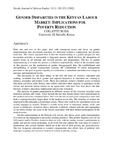| dc.description.abstract | Parts one and two of this paper deal with conceptual issues and focus on gender
mainstreaming into investment activities for increased women’s employment and poverty
reduction. The central argument here is that the mainstreaming of a gender perspective into
investment activities is necessarily a long-term process which involves the integration of
gender issues in all national and sectoral policies and programmes. The key to gender
mainstreaming is to make the process a collective responsibility. Some of the essential steps
in this process are the production of gender disaggregated data, the establishment and
strengthening of gender management systems, the commitment of senior management
personnel to the goal of gender equality as a reflection of attitudinal and behaviour change at
personal and institutional levels.
The discussion in part three brings to the fore the issue of women’s education and
training. Available data show gender and regional disparities in education and training at
primary, secondary and tertiary levels. These data indicate women’s limited access to formal
education and lower adult literacy rates which undermine their capacity to participate in the
formal and informal labour market on an equal basis with men. Part four shows the link
between women’s education, employment and poverty reduction.
The analysis of gender participation in different sectors of the economy revealed some
important patterns and trends. These include the fact that female labour force participation in
the modern sector has remained below 30% over the last several years compared to men who
hold a disproportionately larger share of the modern sector jobs. The majority of women are
employed in the education and informal sectors. Those who work in the agricultural sector are
usually engaged as casuals. Women’s overall lower level of education, limited skills, and
access to productive, resources, heavy domestic workload, cultural attitudes and segregation
of the labour market are some of the factors associated with their limited participation in the
modern sector.
Gender representation in the Kenyan civil service also shows gross under-representation
of women in top management and policy-making positions. This gender disparity calls for an
Affirmative and/or Positive Action to deal not only with increasing women’s participation in
public and private sector institutions at all levels but also address the twin issue of women’s
entitlements and cultural barriers which are at the root of their poverty and powerlessness.
The low budgetary allocations to women’s programmes also reflect lack of political will,
improper targeting and non-involvement of women in priority setting | en |

